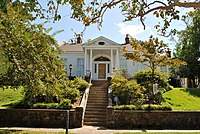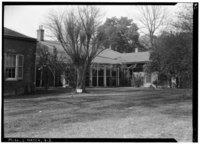|
The Manse (Natchez, Mississippi)
The Manse, also known as Presbyterian Manse, is a historic house within the Natchez On-Top-of-the-Hill Historic District in Natchez, Mississippi. It has been listed on the National Register of Historic Places since March 7, 1979;[2] and is listed as a pivotal property in the Natchez On-Top-of-the-Hill Historic District.[3] LocationThe site is located at 307 South Rankin Street in Natchez, Mississippi, USA.[4][5] It is next door to the antebellum house named Green Leaves. HistoryMargaret Overaker is first known to have owned the property.[6] It was purchased in 1832 for $3,500 by Thomas Macdannold—a rich man about whom not much is known.[6] Macdannold must have had the house built, because the property was purchased just four years later in 1836 for a much higher price ($14,320.88) by Thomas Henderson—a First Presbyterian Church of Natchez elder.[6] The property was purchased in 1838 by the First Presbyterian Church of Natchez to serve as its manse.[7] The previous Presbyterian manse was the Natchez home known as the Elms.[8] The following is a list of some of the Presbyterian pastors who lived in the manse.
ArchitectureAs built in the 1830s for Thomas Macdannold, the home was designed in the Federal architectural style.[6] The home had the fine detailing found in the largest two-story Natchez area mansions, and its front door was among the best in the area.[4][6] When entering from the front door, one stepped into a 9-foot-wide by an 18.5-foot-long hallway with a 17 by 18.5 foot room on each side.[6] Each of these side rooms had a fireplace.[6] At the rear of the front hallway, folding double doors led into a 15 foot wide by 23 foot long back portion of the hallway.[6] This space had an approximately same sized room (14 by 23) on each side of it.[6] Each of these three back rooms had a window, fireplace and a door to the back.[6] A porch ran along the back side of the house.[6] A service wing connected to one end of the rear porch and contained a row of rooms stretching away from the home toward the back of the property.[6] These rooms consisted of a storage room, kitchen, laundry room and enslaved African servants quarters.[6] In 1847 two smaller wings were added to opposite ends of the house.[6] At this point the home had seven rooms with fireplaces in the main portion and a servant's wing off the back of the house.[6] In 1849 a small separate building was added to the property that was used as Reverend Doctor Joseph Buck Stratton's study.[4] The study was designed in the Greek Revival architectural style.[5] In 1895 the dining room, which was then located at one of the rear corners of the main block of the house was divided into three service rooms.[6] The rear portion of the center hall became the new dining room.[6] In 1947–48 the rear porch was enclosed.[6] Despite the need to fit in interior bathrooms and a kitchen over the years, the original design has remained largely intact.[6]
References
External links
|
||||||||||||||||||||||||




